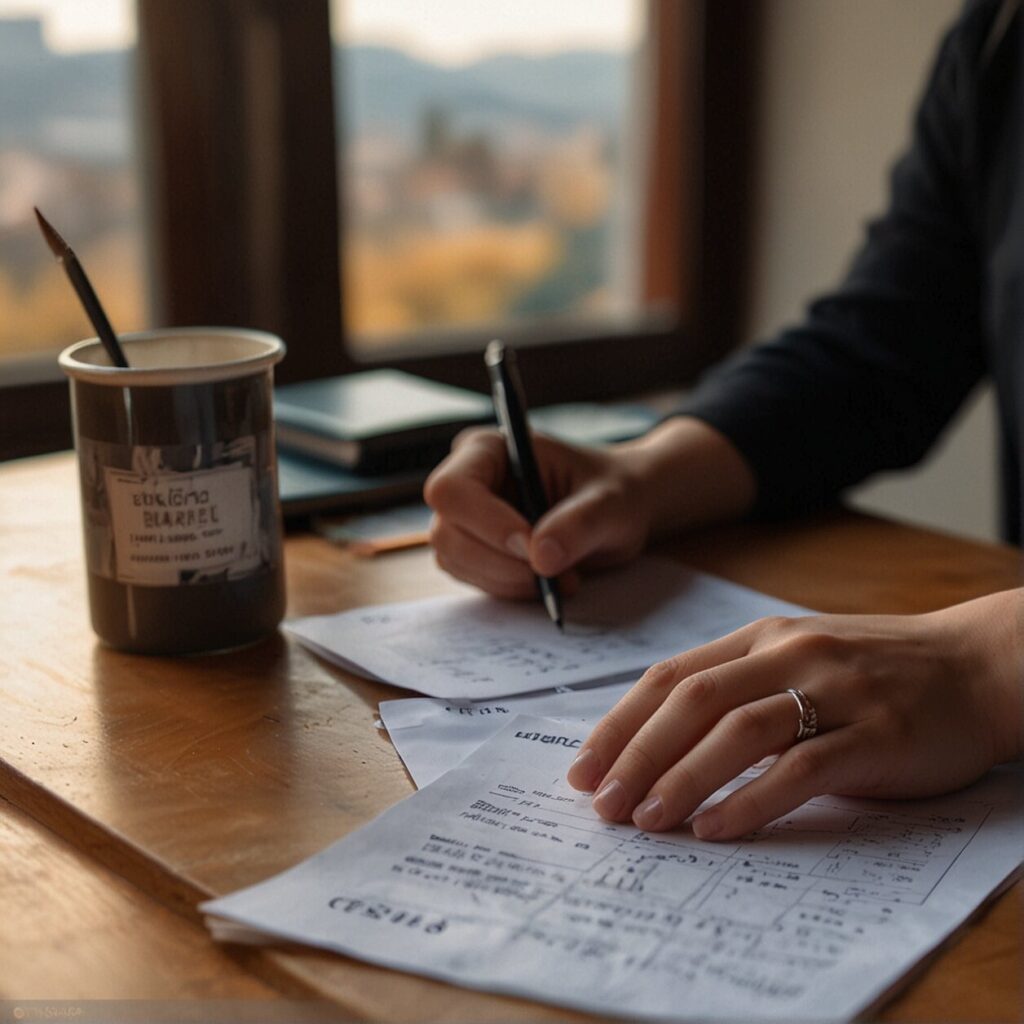Managing Money on the Road: Budgeting Tips for Solo Travelers
Traveling alone has an undeniable charm. It’s an opportunity for self-discovery, meeting diverse cultures, and creating unforgettable experiences. But there’s another side to the coin – managing finances effectively. As thrilling as solo expeditions are, they require careful financial planning and budgeting. This article provides practical strategies to help you smartly manage your finances and still stay organized amidst the allure of new destinations!
“Traveling – it leaves you speechless, then turns you into a storyteller.” – Ibn Battuta
If you’re about to set off on a solo trip, here’s what you’ll find in the next sections:
- Understanding the importance and basics of your travel budget
- Tips for creating a realistic travel budget.
- Guide to prioritize your travel expenses.
- Strategies to manage your in-travel expenses effectively.
- Clever tips to save as a solo traveler.
- Answers to frequently asked questions (FAQs) about solo travel finance.
We’re here to guide you, step by step, through the process of managing your finances while you travel solo and build the memorable adventures you’ve always dreamed of.
Understanding Your Travel Budget: The First Step to Financial Freedom
Understanding your travel budget is an integral part of planning your solo journey. The budget lets you know how much money you have to work with, and this avoids overspending or running out of funds halfway through your trip. There’s liberty in acknowledging your financial limits and finding ways to make the most out of what you have.
There are several elements to include in your travel budget. Most travelers will start with the big ticket items such as flights, accommodation, and food. But don’t forget the small factors like daily transportation, entertainment, and souvenirs. It’s also essential to put aside some money for emergencies— you never know when they might crop up.
Take your time compiling this budget. Research prices, use budgeting tools, and look for people’s advices online who have already gone through this process. Knowledge makes power when it comes to financial management in solo travel. By understanding your travel budget, you take the first step to manage your finance more efficiently, wielding your money with confidence and foresight.

Creating a Realistic Budget for Solo Travel
Embarking on the journey of solo travel can be exhilarating. However, ensuring your monetary means last throughout the journey is paramount, which requires a well-defined budget. Let’s take a look at some key strategies to help you create a realistic and manageable budget for your upcoming travels.
First and foremost, research your destination thoroughly. The cost of living can vary dramatically from one location to another. Collect as much data as you can about the average costs for accommodations, meals, local transportation, and tourist attractions in your chosen destination.
Secondly, always aim to have a margin of safety in your budget. Don’t plan to spend every single penny you have. Unforeseen expenses are a common occurrence in travel, it’s best to be prepared.
Thirdly, find ways to cut costs without compromising on the experience. For instance, participate in free local activities or walk instead of using paid transportation where it’s feasible and safe. Remember that your primary goal is to experience the place and its culture, not necessarily doing everything that costs money.
Lastly, remember to track your spending. It’s very easy to lose sight of your budget when you’re caught up in the thrill of exploring new landscapes. Try to make a habit of jotting down all your expenses. There are various travel-specific budgeting apps designed to simplify this process.
Crafting a solid budget is not about restricting your fun or adventures, but about making smart decisions that allow your money to fund more experiences and travels. Remember, it’s your strategic planning that’s going to make your solo trip successful and financially manageable.
Prioritizing Travel Expenses: What’s Worth Splurging On?
Traveling alone inevitably incurs a variety of expenses, some which may feel more pressing than others. Recognizing when it’s worth investing a bit more can truly enrich your solo trip experience, rather than thinning your wallet without comparable rewards. Let’s delve into key areas where you might consider splurging.
1. Safety: When it comes to safety, never compromise. This can mean staying in a well-reviewed, safe neighborhood even if it costs a bit more. Consider reliable transport services over less secure but cheaper options. It’s your safety on the line, and that’s priceless.
2. Local experiences: Invest in cooking classes, guided tours, or local experiences. These tend to give you a first-hand experience with the culture and can create unforgettable memories.
3. Health & Well-being: Keeping in good health throughout your trip is vital. This could involve opting for wholesome, nutritious meals over fast food options, maintaining your fitness regime even while on vacation, or investing in travel insurance to cover any potential health issues.
4. Comfort: There’s something to be said about the benefits of comfort, especially while traveling. Well-located accommodations, ergonomically designed luggage, or a direct flight might cost more, but they can greatly enhance your travel experience.
Ultimately, careful budgeting doesn’t have to mean denying yourself the occasional splurge. Identifying what’s truly important to you while traveling can make your adventure more fulfilling and memorable, turning the expense into an investment in your solo travel experience.
Managing In-Travel Expenses: Tips to Keep Track
Tripping solo? Kudos to your adventurous spirit, but it’s crucial to keep your travel finances in check as well. You are the only person responsible for your spending, and it’s easy to lose track when you’re caught up in the excitement. Here are a few useful strategies:
1. Consider daily expense tracking
Keep a daily log of your spending. Did you know that small purchases such as snacks, water bottles, or souvenirs can add up quickly? A daily spending log can help you see where your money is going and adjust your behavior if necessary. There are plenty of mobile applications available for this, pick the one that suits you the best.
2. Use cash and card wisely
In many parts of the world, cash is king. But carrying a lot of it comes with risks. You might lose it, or it can be stolen from you. It’s a good idea to carry a reasonable amount of cash for small transactions, while using your credit or debit card for larger ones. Don’t forget to keep an eye on transaction fees!
3. Plan your meals
Eating out can eat into your travel budget fast. Try to find accommodation with kitchen facilities so you can cook some meals yourself. Look out for local supermarkets or farmers markets – it’s healthier, cheaper and gives you a taste of local life!
4. Get a local SIM card
If your trip is a long one, consider getting a local SIM card for data and local calls instead of racking up expensive roaming charges. You can keep a track on your usage and recharge as needed.
Remember, a successful solo trip isn’t just about the exciting experiences, but also how wisely you managed your finances. Stay mindful about where your bucks are going so you can make the most of your adventure!

Smart Savings for Solo Travelers: Frugal Travel Hacks
Traveling solo doesn’t have to run you dry; with some proven, tactical savings hacks, you can preserve your budget while still having an unforgettable journey. We understand that navigating your financial situation can seem daunting, especially when it’s just you on the road. So, here we go with a couple of frugal travel hacks.
Hack #1: Embrace Free Activities
The beauty of traveling lies not only in ticking off well-known, touristy spots but also in discovering off-the-beaten-path locales and experiences. Many fantastic, memorable activities often cost little to nothing. Free walking tours, parks, community events, local markets, and public beaches are some examples. A digital search or a conversation with locals can uncover a treasure chest of free things to do that will let you soak in the local flavor without forking out a cent.
Hack #2: Go Incognito While Booking Flights
Did you know that flight costs can change based on your online tracking cookie? When booking your flights online, go incognito or clear out your web browser cookies. This can prevent airline websites from tracking your visits and possibly hiking up the prices based on your search frequency. This simple hack might just land you a more affordable ticket.
Hack #3: Choose a Travel Credit Card with No Foreign Transaction Fees
Small expenses like foreign transaction fees can sneak up and build into more substantial, unwelcome costs. Consider obtaining a travel credit card with no foreign transaction fees before your journey. They often come with the added benefit of earning travel rewards or points, which can be redeemed for flights, hotel stays, and other travel expenses in the future.
Hack #4: Taking Advantage of Happy Hour Specials
Many restaurants and bars around the world offer “Happy Hour” specials, offering discounted food and drink prices. It’s the perfect way to enjoy local cuisine without breaking the bank. However, indulge in moderation. Although you’re saving money now, don’t forget about the potential expenditure if you let loose a bit too much.
By utilizing these simple yet effective hacks, you can stretch your travel dollars much further, making your solo travel adventure more affordable and satisfying.
FAQ’S
Navigating the financial aspects of solo traveling can sometimes feel like navigating a labyrinth. It’s easy to get lost amid all the unexpected expenses, fluctuating exchange rates, and tricky budgeting situations. But don’t worry, we’re here to lend a helping hand! Let’s dive into some Frequently Asked Questions (FAQs) that aim to simplify the process. Here, we’ll address all your burning questions and provide solutions to commonly-faced financial challenges during solo travels.
What are the best budgeting apps for solo travelers?
Digital solutions like budgeting apps can be a great help to manage your money while traveling solo. They’re user-friendly, convenient, and handy in a pinch. Here are some of the best budgeting apps perfect for solo travelers.
Mint: This app offers a user-friendly platform for you to track your expenses, create budgets – including ones for travel – and manage your money on the go. Plus, it also syncs with your bank accounts and credit cards, providing real-time updates on your spending.
Trail Wallet: This is a travel-centric app that focuses on helping you manage your travel expenses. It allows you to set a daily budget and track your expenses against it. The app can handle multiple currencies which is especially useful for solo travelers.
XE Currency: If you’re traveling internationally, this app is a must-have. This app offers live currency exchange rates and can convert almost every world currency. It’s perfect if you want to quickly figure out how much something costs in your home currency.
You Need A Budget (YNAB): This app follows a proactive approach to budgeting. It encourages you to assign every dollar a job and plan for both big and small expenses. The app can be a game-changer when it comes to managing finances while traveling solo.
By utilizing these budgeting apps, you can have a clear sight of your spending habits and manage your travel budget effectively and effortlessly. Remember though, an app is simply a tool – your financial discipline is still the most crucial part.
What are the common financial mistakes solo travelers make?
We all make mistakes, and that’s perfectly normal. However, it’s important to be mindful of the potential financial missteps that could derail your solo travel experience. Here, we would be highlighting some common financial pitfalls that most solo travelers sometimes fall into and providing helpful insights on how to avoid them.
Firstly, many travelers underestimate the cost of meals, transportation, and emergencies. It’s easy to forget these expenses in the excitement of planning a trip, but they can quickly add up and cause you serious money headaches. As such, it’s crucial to allocate a decent amount for these unforeseen expenses in your budget.
Another common mistake is not taking into account currency exchange rates. It’s essential to do a quick check of the conversion before you leave, and keep an eye on them throughout your trip if you’re visiting multiple destinations. Once you have a clear grasp of the rates, you can make an informed decision when withdrawing local currency and avoid excessive conversion fees.
Avoid being too rigid with your budget. While it’s commendable to strictly adhere to your financial plan, remember to incorporate some flexibility. The beauty of solo travel lies in its spontaneity, in experiencing unexpected adventures that are usually the highlight of your trip. Having a small buffer in your budget to accommodate such moments can make your trip even more memorable.
Lastly, one of the biggest mistakes you can make is not investing in travel insurance. While it’s an additional expenditure, it can potentially save you a lot of money especially in case of medical emergencies or sudden trip cancellations. Always remember that prevention is better than cure, and this applies to your finances as well.
Now that we’ve highlighted these common mistakes, you can better navigate your financial planning and enjoy a stress free solo-travel experience.
How to handle emergencies financially while traveling solo?
Emergencies when traveling solo can be unnerving, but the right strategy can help you manage financially without undue stress. The trick is to plan in advance, understanding that unexpected scenarios can arise anytime and anywhere. Here is how you can financially handle such instances.
Establish an emergency fund: Start by setting aside a certain sum of money in your savings, exclusively for emergencies while traveling. This fund acts as a safety net in case of unforeseen situations like medical emergencies or sudden itinerary changes due to abrupt travel advisories.
Get a reliable travel insurance: An important but often overlooked part of solo travel planning is getting an adequate travel insurance. This can cover a majority of costs from emergency medical treatments to trip cancellation or delay, lost luggage or any unwelcome crisis. Always pay attention to what your insurance covers and more importantly, what it doesn’t.
Keep multiple cash sources: Don’t rely on a single source of money. Use a mix of cash, debit cards, and credit cards. You can carry just enough cash for daily expenses and keep the rest in a safe place. This way, if you lose your wallet or are a victim of theft, not all your funds will be compromised.
Stay connected: Always inform your bank about your travel plans to avoid a sudden halt on your cards due to suspicious foreign transactions. Have your bank’s customer service number handy, in case you need to report a stolen card or dispute a transaction.
Stay informed: Keep tabs on local news for any signs of political unrest, natural disasters or any problems that might affect your travel. You can do this through local websites, news apps, or social media postings from people in the area.
Remember, the best defense against any predicament is always a robust contingency plan. Be always prepared for things not going as planned. The more you plan, the less the impact a mishap will have on your solo trip, both financially and emotionally.
How can I save on food while traveling alone?
Eating while traveling can be one of the most enjoyable experiences, but it can also eat a significant chunk out of your budget if not managed wisely. Luckily, there are ways to save on food while savoring the local cuisine.
A great first step would be to conduct a little research before you embark on your journey. Try to find out about local food prices and the best inexpensive places to eat. Websites and apps like TripAdvisor and Yelp can provide you with information and reviews.
Consider opting for local markets and grocery stores. These often have a wide variety of fresh and local produce and products that not just helps you save money, but provides a closer look at the region’s food culture. If your accommodation has cooking facilities, you could certainly save a lot by preparing some of your own meals.
Another fantastic tip is to have your main meal at lunch. In a lot of places, you will find restaurants offering lunch specials which are cheaper than eating out at dinner. Trying street food is also a great option while traveling alone. Street foods are usually affordable, authentic, and absolutely delicious!
Avoid touristy areas when dining as these places tend to have prices significantly higher to accommodate for the higher rent costs.
And finally, proper hydration is key, especially when embarking on long sightseeing days. Carrying a refillable water bottle helps you stay hydrated while saving unnecessary expenses on bottled water.
With a bit of planning and flexibility, it is absolutely possible to enjoy local food experiences while sticking to your budget.
What are some affordable destinations for solo travelers?
The allure of exploring new cities, vibing with different cultures, and mingling with the locals doesn’t always come cheap. However, some destinations offer a budget-friendly experience, making solo travels more enjoyable.
1. Vietnam: Overflowing with rich history and vibrant street life, Vietnam is a backpacker’s dream. Living costs are extremely low, and the food is divine and affordable. Whether you’re cruising along Ha Long Bay or wandering around Hanoi, there’s a plethora of activities that won’t break the bank.
2. Hungary: While Europe can be expensive, Hungary is surprisingly budget-friendly. Get lost in the architectural beauty of Budapest, soak in historic thermal baths, or explore the renowned wineries within a limited budget.
3. Nepal: Home to the stunning Himalayas, Nepal offers frugal options for accommodations and incredible trekking experiences.
4. Peru: Backpacking through Peru is quite affordable. Don’t miss the Inca Trail to Machu Picchu and striking landscapes of the Sacred Valley.
5. Thailand: With inexpensive local cuisine, budget guesthouses, and iconic sights, Thailand remains a favorite among solo travelers.
In sum, careful selection of your destination can make a significant difference in managing your finances and simultaneously maximizing your travel experiences while traveling solo.







